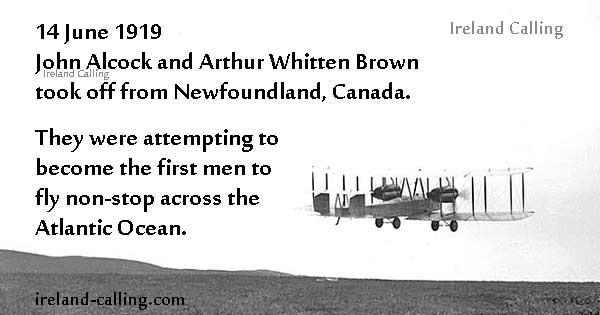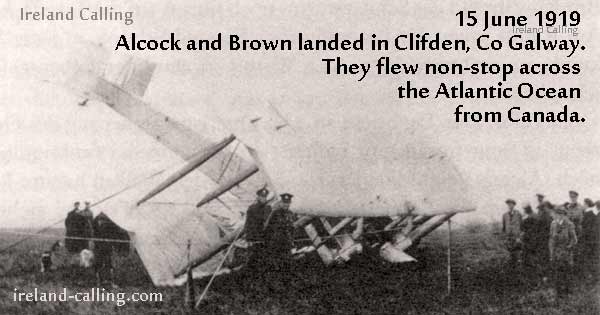The first non-stop transatlantic flight took place in June 1919 when aviators John Alcock and Arthur Whitten Brown flew their aircraft from Newfoundland to Clifden in Co Galway in Ireland.
They carried a small amount of mail with them, meaning it was also the first transatlantic airmail flight. The two British aviators were honoured by King George V, who awarded them the title of Knight Commander of the Most Excellent Order of the British Empire (KBE).
There is a statue of Alcock and Brown at London Heathrow Airport.

Alcock and Brown were both pioneers of air travel, which at the time was cutting edge technolgy and highly dangerous. Alcock was born in Manchester in England in 1892 and started flying when he got his aviator’s licence at the age of 17.
He served as a pilot in the First World War and continued flying afterwards in exhibitions and competitions. Brown was born in Glasgow in 1886. His American parents moved to Manchester shortly after the birth.
Brown was an engineer and also served as a pilot in the war.
Alcock first conceived of flyng the Atlantic when the English newspaper, the Daily Mail, offered a £10,000 prize…a huge sum at the time and still a substantial figure today.
The money was available to the aviators “who shall first cross the Atlantic in an aeroplane in flight from any point in the United States of America, Canada or Newfoundland and any point in Great Britain or Ireland in 72 continuous hours”.
Alcock teamed up with the Vickers engineering company, which decided to use its Vimy IV twin-engined bomber for the challenge. Brown was then hired as navigator.
The two men set off from St John’s in Newfoundland at 1.45pm on 14 June. The flight was frought with difficulties from the outset.
The plane was so heavy after being overloaded with fuel that it almost crashed into some treetops at take-off. Their generator broke down which meant they had no radio and their heated suits failed, exposing them to freezing conditions.
They also encountered thick fog and snowstorms, making it difficult to navigate; for part of the flight they weren’t even sure they were travelling in the right direction.

They landed near Clifden in Co Galway at 8.40am on 15 June, having completed the journey in less than 16 hours. From the sky, they thought they were looking at a green field but in fact was a wet marsh-like area.
However, they safely landed without any injuries and became the first men to fly non-stop across the Atlantic Ocean. They were feted as heroes and were knighted by King George V within a few days.
On a hill 2km south of Clifden, Co Galway, is a memorial commemorating the first non-stop transatlantic flight. It is about 2km north of the landing site, which is in the bog in the photo’s background.

The inscription on the memorial reads;
This memorial honours the achievement of John Alcock and Arthur Whitten Brown the first men to fly non-stop across the Atlantic Ocean
On the morning of the fifteenth day of June nineteen hundred and nine- teen they landed in their aircraft five hundred yards beyond the cairn which can be seen one and a half miles south of this point having left St. Johns, Newfoundland sixteen hours and twenty seven minutes before. The aircraft was a Vickers Vimy biplane powered by two Rolls- Royce Eagle VIII engines of three hundred and fifty horse power each and the average speed during the flight was one hundred and fifteen miles per hour.
Dedicated this the fifteenth day of June nineteen hundred and fifty nine.
* * *
Alcock was killed less than six months after the record making flight when his plane crashed in France on 18 December, 1919 on way to the Paris airshow. Brown continued working in aviation until his death of 4 October, 1948.
More history articles
The Neolithics – first people to leave their mark on Ireland